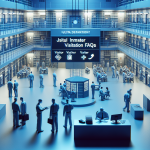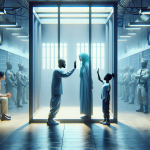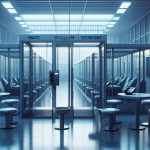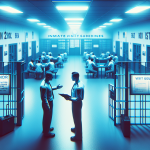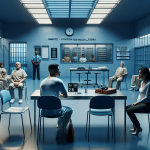Visiting a loved one in the San Diego Correctional Facility can be a trying experience, so it is important to understand the inmate visitation overview. Visitation takes place on Saturdays and Sundays from 8:00am – 2:00pm, and ceases 1/2 hour before closing for the day. All visits are on a first come, first served basis and all visitors must have an approved visit application from the institution. It is important to note that all visitors must register for visitation prior to the day of visitation.
During visiting hours all inmates are allowed to maintain contact with family and friends through face-to-face visitations. The San Diego Correctional Facility provides visitors with the ability to converse and interact with their incarcerated loved ones in the form of video visitation. Access to video visitation is available from the institution for visitors to speak with their inmate without having to travel to the facility.
Inmates may be allowed to have more than one person visiting at one time, however, the institution requires that visitors log in and out of the visitation area concurrently. Visiting room capacity is limited to six adults and two children per visiting area, and all visitors must remain within arm’s reach of the inmates at all times. At no time may visitors hand off items to inmates or converse outside of the visiting room.
All visitors are expected to dress in a respectful manner, and must remain professional and courteous while visiting. Offensive language, gestures, postures, or clothing are prohibited and can result in visitors being barred from the institution. In order to prevent contraband from entering the facility, all visitors must comply with the facility’s security procedures. These procedures include, but are not limited to, frisk searches, metal detector checks, signed advisories and all items brought into the visiting area must be approved by the security staff.
The San Diego Correctional Facility strives to maintain a secure and respectful environment for all inmates and visitors alike. By familiarizing oneself with the inmate visitation overview, one can ensure that their visit to the facility is both meaningful and safe.
San Diego Correctional Facility – Overview and Information
The San Diego Correctional Facility (SDCCF) is an important facility located in San Diego, California. The SDCCF, which is part of the California Department of Corrections, is responsible for providing secure and safe containment for inmates serving out sentences for a variety of crimes. The facility is divided into two different types of housing: minimum and medium. Medium security inmates have greater rights, more privileges, and a more lenient lifestyle than minimum security inmates.
SDCCF is the only maximum security correctional facility in Northern San Diego County and also houses prisoners sentenced for various California crimes. The facility has a variety of programs for offenders including education, vocational training, community outreach, and research-based programming. Most inmates are assigned to jobs in the facility’s industrial shops and/or in community support programs that allow them to work and learn job skills.
Inmates are scheduled for routine visits with psychiatrists and other medical staff, as well as rooms and workspace dedicated for psychotherapy sessions. Inmates may also receive treatment for alcohol and drug addiction, and participate in the Wellness Program, which provides health services, such as substance abuse treatment and anger management classes.
The facility also has a library and computer lab, which allow inmates to study, read books, as well as take special courses. Inmates who are enrolled in these courses are eligible for credit for their successful completion.
The SDCCF is a strict secure facility, and inmates must follow strict rules and guidelines while in the facility. Inmates can be placed in segregation for violating the rules or failing to comply with orders of staff.
Inmates released from the San Diego Correctional Facility are eligible for a variety of reentry services. The California Department of Corrections provides assistance with finding employment, housing, substance abuse counseling, and other supportive services. Inmates are also eligible for the Parole Board to consider them for early release. The Parole Board is a committee which reviews the inmate’s file to determine whether they should be released.
San Diego Correctional Facility – Classes, Services, and Programs
San Diego Correctional Facility, located in San Diego, California, offers a variety of classes, services, and programs to help individuals who are incarcerated.
The classes offered at San Diego Correctional Facility include education courses, life-skills courses, parenting courses, and job-related courses. Education classes focus on teaching individuals the basics of reading, writing, language, and math, while life-skills classes teach important skills such as financial literacy and problem solving. Parenting classes focus on understanding parenting roles and how to manage a household. While job-related classes teach basic employability skills, help with resume writing, provide interview preparation, and more.
In addition to classes, San Diego Correctional Facility also offers services and programs to further assist incarcerated individuals. Their Substance Abuse Treatment program gives individuals the opportunity to receive counseling, group therapy, and education about the disease of addiction. They also provide Domestic Violence Treatment for individuals who may have been convicted of domestic violence-related charges. This program is designed to help people understand the dynamics of a healthy, non-violent relationship and help them develop better communication and conflict-resolution skills. Further, San Diego Correctional Facility also provides Mentoring Services. This program matches volunteers with inmates to create an ongoing relationship designed to provide support and a positive role model upon their release.
In conclusion, San Diego Correctional Facility offers a variety of classes, services, and programs to help incarcerated individuals better prepare themselves for a successful return to society. These classes, services, and programs strive to help individuals gain the knowledge and skills they will need to make positive choices after release.
Inmate visiting application in San Diego Correctional Facility
San Diego Correctional Facility has a strict inmate visiting application process that must be followed in order to visit an inmate in the facility.
The first step in the application process is to complete the Inmate Visiting Application Form. This form can be found online, or you can obtain a copy from the facility. All of the questions must be answered completely and accurately. The form must then be signed and dated by the applicant and a witness.
The next step in the process is to send the completed form to the facility. It can be mailed, faxed, or brought directly to the facility. If the facility accepts the form, you will be given an authorization number and the inmate will be notified. It is important to note that the application process can take up to two weeks to be completed.
Once the application is approved, there are several requirements that must be met prior to visiting the inmate. All visitors must produce a valid form of photo ID when they arrive at the facility. All visitors must also pass a background check, which typically involves showing proof of a clean criminal record and that the individual is not currently under any other court- Issued orders.
Once all of these steps have been completed, the visitor will be given an appointment time to visit the inmate. Appointments must be kept on time and visitors must comply with all of the facility’s visiting rules. Failure to comply may result in a suspension of visiting privileges.
Visiting an inmate at San Diego Correctional Facility can be a lengthy process, but it is an important way to provide support to the inmate. Following the above steps will ensure that the process is completed quickly and properly.
San Diego Correctional Facility: Frequently Asked Questions and Answers
Q: How long can someone be incarcerated at the San Diego Correctional Facility?
A: The length of time that someone can be incarcerated in the San Diego Correctional Facility depends on the crime they are convicted of and the type of sentence they receive. Typically, sentences can range from one year to life for felony convictions and much shorter for misdemeanor convictions. It is also important to note that individuals charged with violating federal laws will have their sentences decided by a federal court.
Q: What type of services are available to inmates at the San Diego Correctional Facility?
A: The San Diego Correctional Facility provides several services to inmates to help support their successful reentry back into society. Services such as educational programming, physical and mental health services, and employment training are available to inmates to ensure that they gain the skills and resources they need to reintegrate into society. In addition, the facility also offers group counseling, substance abuse programs, and social activities for inmates.
Q: What is the visitation policy for the San Diego Correctional Facility?
A: Visitation is allowed at the San Diego Correctional Facility, however all visits must be approved by the inmate’s supervising officer. Visitation hours are generally held on the weekends and visitation sessions are limited to one hour. It is important to note that not all inmates are eligible for visitor privileges, as eligibility is determined based on the behavior and the security level of the inmate.
Q: Are there any resources available for the family and friends of incarcerated individuals?
A: Yes. The San Diego Correctional Facility offers several resources for families and friends of incarcerated individuals. For siblings and parents, the facility offers support groups and counseling services. In addition, the facility also provides reentry resources and workshops for family members to help them adjust to their loved one’s return after their release. Family members are also welcome to attend educational programs at the facility to learn more about incarceration and the criminal justice system.

